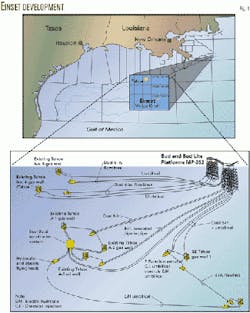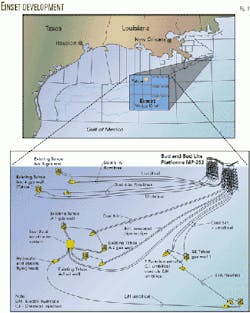The Einset discovery is one of the latest announced deepwater Gulf of Mexico development projects.
This Shell Exploration & Production Co. (SEPco) project will have one subsea completion tied back 5 miles to Shell's Southeast Tahoe subsea manifold, Viosca Knoll Block 784, which is tied back 12 miles to Shell's Bud Lite platform, Main Pass Block 252, in 275 ft of water (Fig. 1).
Subsea controls for the new development will extend from Bud Lite through the Southeast Tahoe umbilical terminataion structure and a 7-mile umbilical to Einset.
Einset
Einset, in 3,500 of water, is 170 miles southeast of New Orleans in Viosca Knoll Block 872 and will produce from Viosca Knoll Blocks 872 and 873, acquired by Shell in March 1998. The discovery well was drilled in December 1998 and side tracked in January 1999.
Shell operates Einset with a 50% stake, and Dominion Exploration & Production Inc., Richmond, Va., holds the remaining working interest.
Steve Sears, Shell's manager of subsea development, said Einset's production is slated to begin in February 2002. The company expects the project to recover more than 30 bcf of gas with peak production rates of up to 60 MMcfd from a 25-ft thick turbidite sand at about 9,620 ft subsea.
It says the reserves are primarily gas with some 40° API liquids containing no sulfur.
SEPco expects the initial development will cost less than $40 million.
Tahoe
In the adjoining Tahoe development, Shell is operator and has a 70% interest in the wells and subsea systems. Murphy Exploration & Production Co. has the remaining 30% interest. Shell has 100% interest in the Bud and Bud Lite platforms and surface facilities.
The Tahoe discovery well was drilled in 1984 on Viosca Knoll 783. Four wells and three sidetracks evaluated the discovery before development commenced.
The $27-million Phase 1 of the Tahoe development included one subsea well tied back to the Bud platform with production beginning in January 1994. In the $160-million Tahoe Phase 2, Shell added three gas wells and one oil well.
In Phase 2, the No. 5 gas well, in Viosca Knoll Block 783, is a single satellite well with its own umbilical and two 6-in. flowlines. The other two gas wells and the oil well are in a central cluster and share electro-hydraulic and chemical injection umbilicals via an umbilical termination structure and hydraulic distribution manifold.
The two central cluster gas wells are daisy chained, sharing a pair of 6-in. flowlines. The oil well is served by two 4 by 8-in. pipe in pipe insulated flowlines.
Drilling of the four Phase 2 wells began in September 1995 and these wells are tied back to the Bud Lite platform, which Shell describes as a hybrid of a new jacket and older deck and facilities taken from its Picaroon field, Brazos Block A19, C platform.
Installation of Bud Lite was completed in May 1996 and Shell says it has a capacity to handle 300 MMcfd of gas, 12,000 bbl of condensate, and 8,000 bo/d.
Production from Phase 2 began in August 1996 from the No. 5 well with the three other wells beginning to produce in April 1997. Shell says peak production from Tahoe Phase 2 occurred in September 1997 at a rate of 123 MMcfd of gas and 5,150 b/d of oil and condensate. In June 2001, Tahoe production was 79 MMcfd of gas and 2,200 b/d of liquids.
Shell's estimate places total ultimate recovery from Phases 1 and 2 at about 120 MMboe.
Southeast Tahoe
Shell discovered its 100% owned Southeast Tahoe field, Viosca Knoll Block 784, in March 1996. The well was completed in June 1996 with first production beginning in October 1996.
Shell says peak production was 100 MMcfd for the $28 million project. In late June 2001, the well was producing 30 mmgcfd of gas and 170 b/d of liquids, according to Shell.



